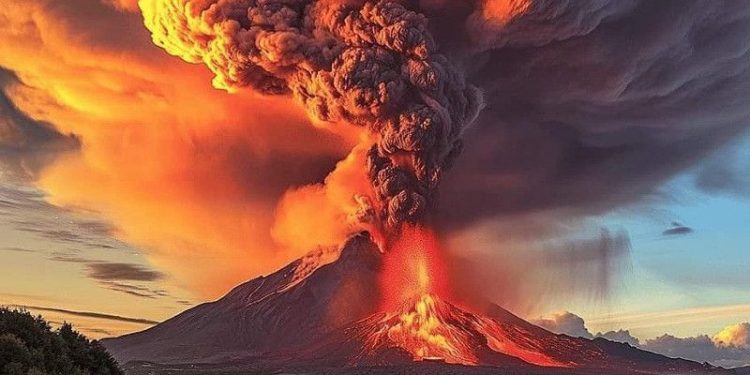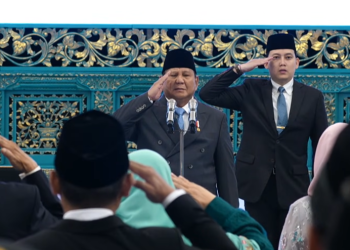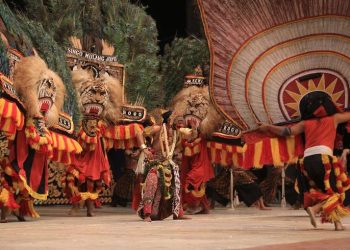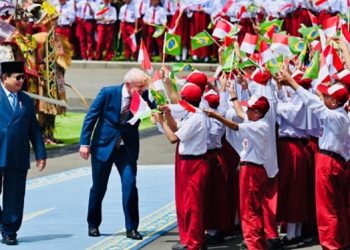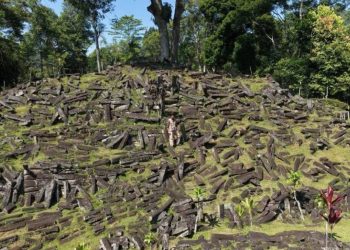Jakarta, Indonesia Sentinel — Mount Lewotobi Laki-laki, located in East Flores, East Nusa Tenggara (NTT), Indonesia, erupted with deadly force in the early hours of Monday, November 4, 2024. This tragic event left 10 people dead, injured dozens, and caused widespread destruction in nearby villages as volcanic material and ash blanketed homes and infrastructure.
The Indonesian National Disaster Management Agency (BNPB) reports that the eruption impacted seven villages. Six of these villages are in Wulanggitang District—Pululera, Nawokote, Hokeng Jaya, Klatanlo, Boru, and Boru Kedang—and one is located in the Ile Bura District, Dulipali. Authorities have closed four airports across Flores Island: H Hasan Aroeboesman Airport in Ende, Soa Bajawa Airport, Gewayantana Larantuka Airport, and Frans Seda Maumere Airport, all essential transit hubs for both local residents and tourists.
Mount Lewotobi, often referred to as the “twin mountains,” has two peaks, Lewotobi Laki-laki (1584 meters) and Lewotobi Perempuan (1703 meters), located about two kilometers apart. These twin peaks have long been the center of local legends that blend nature and spiritual beliefs, influencing the lives and traditions of nearby communities for centuries.
The Myth of Mount Lewotobi: The Twin Mountains

According to local lore, the Lewotobi mountains were once known as Ile Bele, or “Great Mountain,” considered an ancestral source of power. Over time, the mountain was divided into two peaks, with each taking on the symbolic identities of male and female: Lewotobi Laki-laki (Male) and Lewotobi Perempuan (Female).
The origin story of these names is rooted in a legend of two couples, Puka and Tobi, who were part of the local community and considered guardians of the mountain’s spirit. Puka, who was associated with the Male Mountain, was designated a symbolic role known as Mame (meaning uncle) or Opu (meaning in-law) depending on whether they had a daughter or a son. When Puka had a daughter, he became Mame to Tobi’s family, which established a cultural bond between the two communities. Together, these mountain guardians tried to build mountains out of sand and stone to honor the spirit of Ile Bele, but these attempts failed until Tobi’s clan stepped in to strengthen the effort.
Since then, the peaks have been called Lewotobi, and each eruption is seen as a reminder of the mountain’s spirit and the need to honor this ancestral bond.
Cultural Rituals for Protection and Healing
Following the eruption, the Puka clan, considered the mountain’s spiritual caretakers, has a cultural obligation to conduct the Tuba Ile ritual. In this ritual, offerings are brought to the mountain by six representative clans—Puka, Tobi, Kwuta, Wolo, Noba, and Tapun—to appease the mountain’s spirit and bring peace to the community. The offerings include symbolic items meant to restore harmony between humans and nature and to mitigate the mountain’s destructive potential.
Flights to Bali Disrupted due to Mount Lewotobi Eruption, Where Should Travelers Go?
The recent eruption of Mount Lewotobi Laki-laki has reminded the community of their deep-rooted respect for nature’s power. The ritual also highlights the delicate balance that these indigenous communities maintain with their environment, where myths and legends are intertwined with acts of reverence and respect.
For the people of Flores, the eruption of Mount Lewotobi is more than just a natural disaster—it is a time to revisit and honor their heritage, upholding the traditional ceremonies that have helped them coexist with these towering natural giants across generations. Through ritual and respect, they seek to appease the spirits of the mountain, hoping to restore calm in the wake of the disaster and prevent future eruptions.
(Becky)


